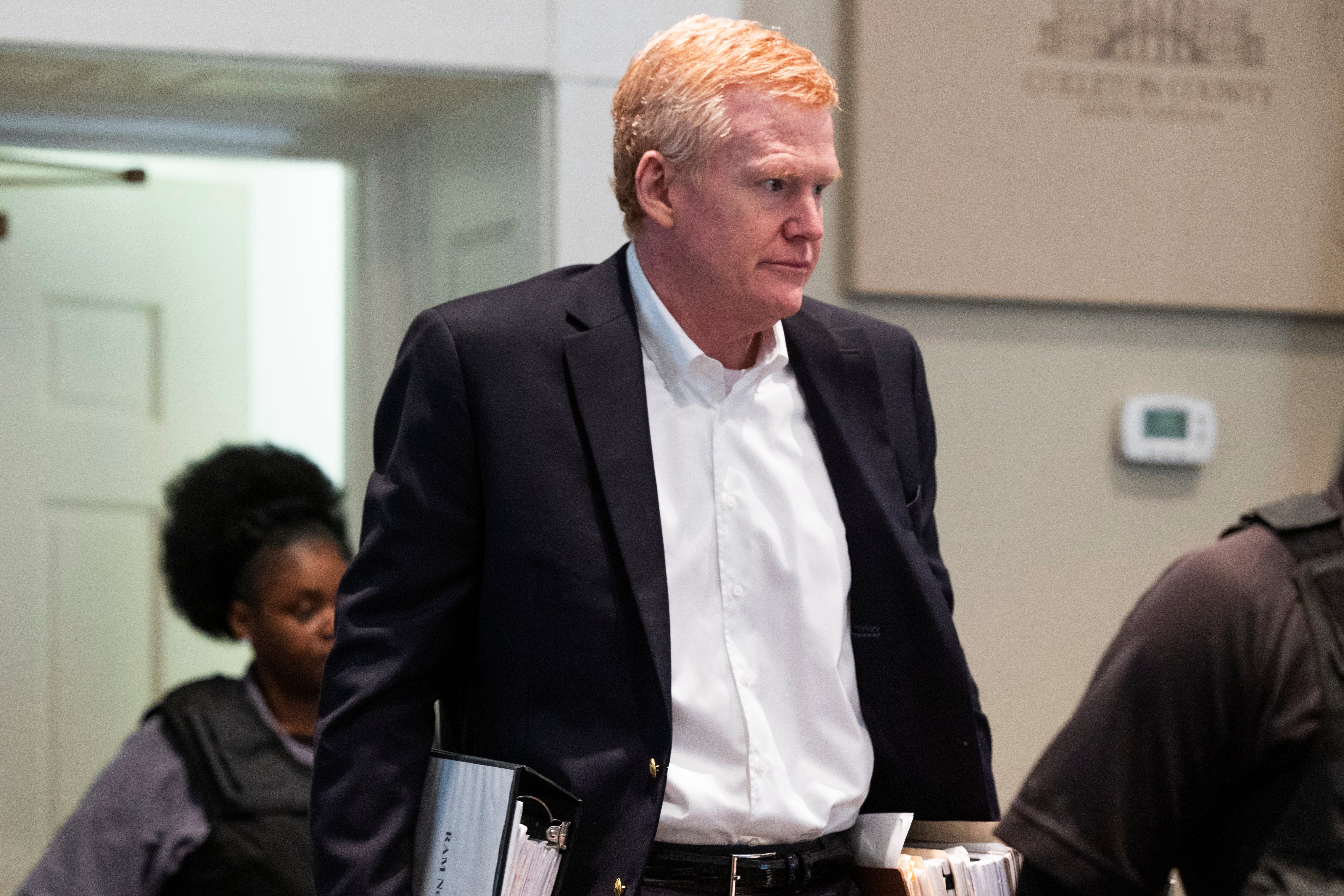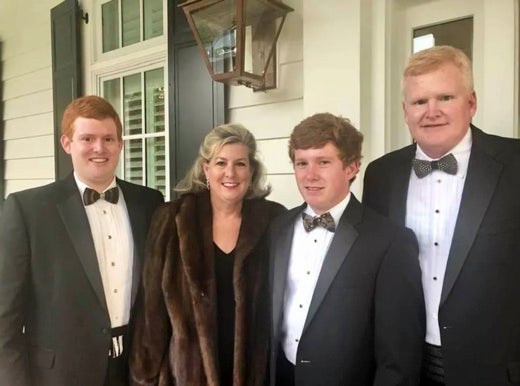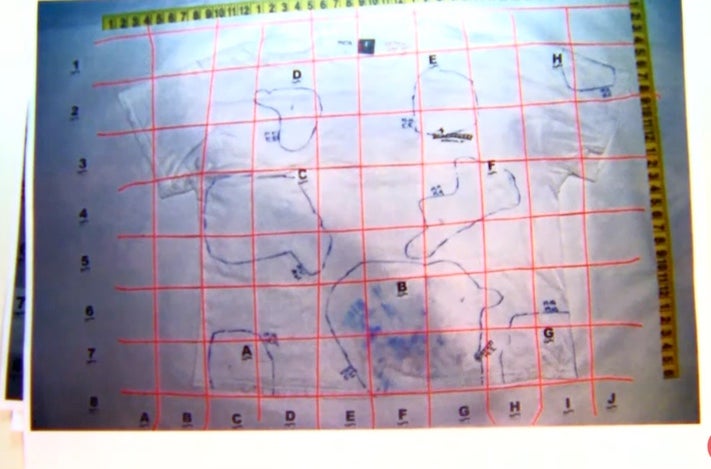Alex Murdaugh defence accuses police of ‘fabricating evidence’ to tie attorney to murders in closing statement
Defence attorney Jim Griffin told jurors SLED ‘failed miserably’ in its investigation into the 7 June 2021 murders and decided from the get-go to pin the crime on Alex Murdaugh
Alex Murdaugh’s attorney accused law enforcement of “fabricating evidence” to tie him to the murders of his wife and son during the defence’s dramatic closing statement.
Defence attorney Jim Griffin told jurors in the Colleton County Courthouse on Thursday morning that the South Carolina Law Enforcement Division (SLED) “failed miserably” in its investigation into the 7 June 2021 murders and decided from the get-go to pin the crime on Mr Murdaugh.
“They had the ability to do the forensic work, they had the ability to interview witnesses and they had the ability to gather electronic data,” Mr Griffin said.
“We believe that we have shown that SLED failed miserably to investigate the case and that had they done a competent job Alex would have been excused from that circle years ago, two years ago.”
He argued that key pieces of evidence that were used to indict the 54-year-old for the murders simply “weren’t true” – and when they were exposed as incorrect, the state changed its theory about Mr Murdaugh’s actions that night.
Mr Griffin told jurors that the botched hitman plot in September 2021 – where Mr Murdaugh claims he asked Curtis Eddie Smith to shoot him in the head so his surviving son Buster would get a $12m life insurance windfall – had made him an “easy target” for law enforcement.
“That made him an easy, easy, easy target for SLED. The evidence was crystal clear,” he said. “From that moment they started fabricating evidence against Alex.”
Mr Griffin insisted he didn’t make “that claim lightly” and pointed to grand jury testimony from a SLED agent that high-velocity blood spatter had been found on the shirt Mr Murdaugh was wearing on the night of the murders.
“They came up with a report that said Alex’s t-shirt had high-velocity blood spatter on it… that means you’re within feet of a shooting,” he said.
The shirt actually tested negative for the presence of human blood.

“That didn’t stop SLED from going out and pursuing with a vengeance this report,” he said.
When the defence disproved the evidence, the state “had a problem on their hands,” he said.
Mr Griffin said that the state then switched its theory from “Mr Bloody Shirt” to “Mr Clean” – with prosecutors now arguing that Mr Murdaugh washed and changed his clothes after the murders.
“They went from Mr Bloody Shirt before this trial to Mr Clean during this trial,” he said.
“And here we are with a Mr Clean theory. That he washed off after brutally murdering Maggie and Paul. He takes a hose and washes himself off, he gets in a golf cart – butt naked I guess – driving to the house.”
Beyond the bloody shirt, he also questioned the blue raincoat as evidence which Mr Murdaugh was accused of using to transport the murder weapons and which he then allegedly hid in his parents’ home.
The jacket – which he was allegedly seen carrying into his parent’s home days after the murders by his mother’s carer – was covered in gunshot residue.
Mr Griffin suggested that a SLED agent misled Mr Murdaugh’s brother John Marvin about where the jacket was found and said that none of Mr Murdaugh’s family members recognised the jacket.
He also cast doubt on the state’s case that “family guns” were used to kill the two victims.
During a closing statement that was highly critical of both the law enforcement investigation and prosecutor Creighton Waters’ closing the day before, Mr Griffin jumped around with his arguments as he tried to pick holes in several parts of the state’s case.
As well as accusing law enforcement of falsifying evidence, he sought to discredit the investigation and argued that investigators had decided Mr Murdaugh was the killer from the start.
He held up a poster to the jury which revealed the statement released by SLED on the morning of 8 June 2021, where officials reassured the community that “there is no danger to the public”.
“Does that tell you that on June 8 law enforcement had decided it had to be Alex Murdaugh?” he asked.
“It’s a fair question for you to ask yourselves. It’s a question that has not been fairly answered in this trial.
“We know that on June 8, Alex was in that circle. And he is at the mercy of the ability of SLED to exclude him from that circle.”

He also hit out at the preservation and collection of evidence from the crime scene, pointing to testimony about tire tracks not being preserved and hair found in Maggie’s hand not being tested.
“We’ve not heard what happened to the hair – was it tested?” he asked, questioning whether it was “evidence of a struggle” with her attacker.
“We don’t know the answer to that,” he said.
Mr Griffin said that the thing that “completely baffled us” was that the state did not test Maggie and Paul’s clothes for DNA – but that they did test Mr Murdaugh’s clothes.
“Was Alex assaulted on June 7? Was Alex wrestling with the assailant on June 7? There’s no evidence of that so why are they taking evidence from Alex’s clothing?” he asked.
“There’s only one reason. It’s that they had decided – unless we find somebody else it’s got to be Alex.”
Mr Murdaugh “desperately” wanted investigators to pull data from his SUV to show that it didn’t match the movements of Maggie’s phone, he said. But he claimed that location data may have been lost from Maggie’s phone because it wasn’t stored correctly.
All in all, Mr Griffin said that if SLED had investigated the murders properly, they would have proof of Mr Murdaugh’s innocence.
“Had they done it, I hope we wouldn’t be here,” he said. “I would hope but probably not because they were so focused on him.”
Mr Griffin admitted that the disgraced attorney’s lies about his alibi on the night of the murders is a key part of the state’s case.
“We are back to the lie. Because that’s all they have in this case, is that Alex lied to them. And he shouldn’t have,” he said.
In the 20 months between the murders and the trial, Mr Murdaugh denied ever being at the dog kennels that night.
But, a cellphone video found on Paul’s phone revealed that Paul, Maggie and Mr Murdaugh were at the kennels just minutes before the murders.
When he took the stand in his own defence, Mr Murdaugh finally confessed that he was there and that he had lied to family, friends and law enforcement about his alibi.
Mr Griffin said that, while Mr Murdaugh shouldn’t have lied, he did so because of his opioid addiction and because he had just found his wife and son’s bodies.
“It wasn’t rational, but he was in the throes of addiction, and he had just discovered his wife and son dead,” he said.
“And they swiped his hands for GSR. And he thought he was being questioned by the same SLED agent who investigated his friend Greg Alexander.”
Despite lying, he largely brushed over the cellphone video being the “eureka” moment he said prosecutors believe it to be.
“There is nothing on that tape that indicates any strife, any conflict, any anger… anybody being afraid, anybody running, anybody scurrying. Nothing. It’s Maggie, Paul and Alex down at the kennel. That’s it,” he said.

He played the video for the jury, saying: “Four minutes later, the state would have you believe that Alex Murdaugh blew his sons brains out of his head and murders his wife after having that conversation about Bubba having a chicken.
“He lied because he had a closet full of skeletons. He was clearly in the throes of addiction. But what he didn’t lie for was to cover up the fact he killed Maggie and Paul.”
While he admitted that Mr Murdaugh lied about the night of the murders, he described the defendant’s incorrect statements about other things as merely “misstatements” and said that his inability to recall the exact timeline of events was because he “was running to his baby”.
“Alex’s statements about time were not lies, they were misstatements,” he said. “He is just wrong on times.”
He added: “You heard yesterday Maggie was running to her baby – Alex was running to his baby. And can you imagine what he saw?”
On the motive, he disputed the significance of Mr Murdaugh’s escalating financial crimes and the prosecution’s argument that this was on the brink of being exposed.
“What kind of sense does that make?” he asked. “He puts himself in the middle of a murder investigation, and he puts himself in the middle of a media firestorm. That’s their motive.”
At several points of the closing statement, Mr Griffin took aim at prosecutor Mr Waters over his “curious” closing statement – and the prosecution table objected at least three times to his arguments.
One objection came when Mr Griffin appeared to offer a brand new theory for the murders – that Paul had confronted his father’s drug dealer for feeding his addiction and found himself up against “a dangerous drugs ring”.
The defence had provided no evidence for such a theory throughout its case.
Judge Clifton Newman sustained that objection.
A bizarre spat then unfolded about an interview Mr Griffin gave to a HBO show last year.
Mr Griffin also hit out at the timeline offered by the prosecution, saying “their theory is… they’re dead the moment they stop using their phones”.
Prosecutors say Maggie and Paul were killed at around 8.50pm with the data suggesting they last used their cellphones at 8.49pm.
Mr Griffin raised doubts that Mr Murdaugh could have killed both victims at 8.50pm, disposed of the evidence and left to go to his mother’s home by 9.07pm – just 17 minutes.
“He leaves the property at 9:07. If it happens at 8:50, he’s got 17 minutes. 17 minutes. He’d have to be a magician to make all that evidence disappear,” he said.
The defence attorney went on to cast doubts on Mr Waters’ statement that he “manufactured his alibi” by making several calls to friends and family members – including to Maggie – after the murders, in a move to try to cover his tracks.
Mr Griffin suggested that, if Mr Murdaugh really wanted to cover his tracks, he would have answered Maggie’s cellphone when he placed calls from his own phone – so as to appear as though she were still alive.
“If he is manufacturing a timeline... the easiest way to do it is use both phones to talk on both phones and he didn’t,” he said.
Instead, Mr Griffin continued to push the defence’s theory that two unknown assailants were responsible for the murders.
“The most common sense thing here is there were two shooters. There were two guns,” he said.
Mr Griffin repeatedly reminded jurors that the burden of proof lies with the prosecution.
“If there is any reasonable cause for you to hesitate when you write ‘guilty,’ then the law requires you to write ‘not guilty,’” he said.
Mr Griffin choked up with emotion as he asked the jury to return a not guilty verdict for the man on trial for murdering “my friend Paul”.
“You’ve heard weeks of testimony about Alex’s financial crimes, drug addiction and lies. But after all that, the state has failed to provide a satisfactory answer to this question: Why? And that’s because the state can’t answer that. Because he would not do it,” he said.
“On behalf of Alex, on behalf of Buster, on behalf of Maggie and on behalf of my friend Paul, I ask that you do not compound one family tragedy with another.”



